Alexandra Juhasz, Pitzer College
Enculturation 8 (2010): http://enculturation.net/on-the-on-line
Introduction
A version of this essay was first given at Brown University in December 2009 as a talk for the animating archives conference.
This version 2.0, for online publication via Enculturation, similarly addresses, but in this journal’s specific format and forum, what remains, for me, the perennial writing question behind my project (teaching, writing, and learning about YouTube on YouTube or at minimum online): how to best use the multimedia of (re)presentation to translate an online experience and analysis, in particular one often spoken on video on and about YouTube. For the conference, I translated some of the text that follows into two video versions (by merely reading the following text as a vlog into my computer’s built-in camera, emphasizing a handmade feel). In conference mode—when such videos play in lieu of my speaking live while I stand below or beside them projected into a room in which I also exist with others—questions of presence and absence, authority, and rhetorical style are raised via form (or format) alone. This does not happen here if you watch via the video links above. Of course, new questions of form, place, and meaning arise via online writing and publication. Given these formal differences, and this journal’s unique interest in rhetoric, writing, and culture, I will attempt to create here a demonstrative hall of mirrors, refracting modes of online writing about video writing about online video on and off YouTube and on and off of each other. I write online about what I learned from teaching and then writing about a class that itself was about and in social video networking.
Three years ago, I came to YouTube, already somewhat late and also downright skeptical.
(Fox and Friends, MediaPraxisme)
I came to YouTube after 20 years of making, writing, and teaching about committed media, particularly the community video work of AIDS and anti-war activists, feminists, lesbians, and queers of many stripes. When I commenced my YouTube project—teaching, learning and writing about and also on the site—I arrived underwhelmed by what I saw there.
(Fred - Christmas is Creepy - Official Video, Fred)
Given the fact of Fred—one of the most subscribed YouTube channels of all time—I remain convinced that this DIY revolution in access to production and distribution carries only some of what is necessary for the realization of the full possibilities of radical, or what I will soon refer to as punk media that video activists, like myself, have long been anticipating, producing, and promoting. Given my specific orientation—as a committed media scholar/maker whose work has focused on individual and community empowerment, and by design, projects to which I am personally related—the questions I ask of YouTube, what I demand of it, what I hope for it, where I try to push it, are both personal and political (i.e. feminist) in nature.
I believe in people-made radical culture that relies upon, references, and produces historical and theoretical knowledge; that is committed to an articulated project of world or self-changing, that occurs in a named place and within a known community; that is also community-producing, by which I mean part of a larger project enabled by a flexible, adaptive, or strategic grouping of individuals around specific goals, histories, theories, and media practices which include making, watching, education, distributing, archiving, curating, and analyzing. While most of YouTube and its videos do not succeed in these goals, some uses do, and much more could. I suggest that my teaching, writing, and publishing on YouTube is only one of many productive or radical uses of the site (TheJump is another: an undergraduate, peer-reviewed, online journal of student-made multi-media projects), uses that enable community, critique, context, and control in a resistant online environment and within the very forms and forums under consideration. As I suggest across my YouTube project: while access to production and distribution has become readily available, and widely taken advantage of, the harder and necessary contributing components of media literacy, theory, history, and politics must also be written into uses of Web 2.0 that meet my lofty goals for media empowerment.
(Queer Realism on YouTube, Juhasz conference talk, ½, Mediapraxisme)
But, ever a good feminist, this essay is not so much about this content—my analysis and criticism of YouTube built through teaching, blogging, watching, and making video there over these 3 years, although this bubbles up everywhere inseparable from what holds it—as much as it is about the forms that I have been developing, in collaboration with others, to represent and re-represent these mostly pessimistic ideas about YouTube (which is to say to publish this work) in the very same digital environment where YouTube challenges and changes the radical potential of video. To be clear: if you are interested in my ideas about YouTube read the “video-book,” which is slated for publication (and will be available for free) with MIT Press, in winter of 2010. In this publication my goals are different and more refined: I will discuss the processes I have engaged in response to the dreaded “3-V’s” of the digital humanities: volume, variety, and vernacular. (And, I call my linked problem-solving processes the “3-C’s”: control, context, and community.) I hope that you will soon see how these cute little lists are themselves formal responses to the related publishing setbacks associated to duration and translation (from academia to on-lineia, from long to short, from multitudes to ones, from complexity to clarity: little lists).
(Summary of Learning from YouTube at the midterm 2, Mediapraxisme)
Following along this formal line that was itself modeled upon the making and use of summaries and lists that was first developed when I tried to speak about YouTube on YouTube (where everything needs to be quick!), in this online essay about writing about YouTube, I will focus on eight dilemmas I faced when working towards “publishing” what had become, after 2 years, a huge body of work (essays, blogs, talks, videos, interviews). I did so with the institutional and creative support of Vectors and through the generous support of the University of Southern California's (USC's) IML, the National Endowment for the Humanities (NEH), and the Andrew W. Mellon Foundation, by transforming my unwieldy digital processes and their many diverse texts into an online “video-book.” For this particular publication in Enculturation, I will showcase a slice of a draft of the larger “work” (which showcases the DIY/Punk YouTour as well as the tag, Pedagogy, and a few related “texteos”—text+video) to show and explain how the designer and programmer, Craig Dietrich, and I formally worked through questions about audience, attention, design, interaction, linearity, multi-modality, and borders (questions of import, I believe for all publishing digital humanists). I will conclude twice, first with reflections on how writing about and on YouTube has forever altered my understanding about the meaning of digital humanities in that I will suggest it has the capacity to push all scholars to not only account for our intent, but also then, the ethics of our digital intellectual efforts, and then with some thoughts about authoring about and in a database.

This is the now-obsolete opening page of a thing variously known as “the work,” “the publication,” “the book,” or “the video-book,” its titular status forever but productively and definitively unclear in that it holds enough words to be a “book” (my contract with MIT asks only for a word count; they remain uninterested in a video or time count, and interestingly, the word count is an obsolete hold-over from paper, there to ensure the “book” doesn’t get too big and too expensive to produce, obsolete because this “video-book” will never be on pieces of expensive paper), and even holds five long “chapters” (full essays and lectures), and yet, also holds small “slogans” of writing, medium-size nuggets of text, and then hundreds of videos, some standing entirely alone on a page. Argh.
Working our best against the chaos of YouTube, we instead created four more transparent and reasoned routes that the “video-book” uses to structure its critical thinking about YouTube: tours

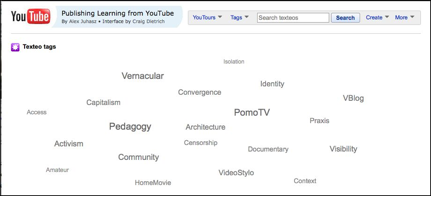
and triage

organize its texteos
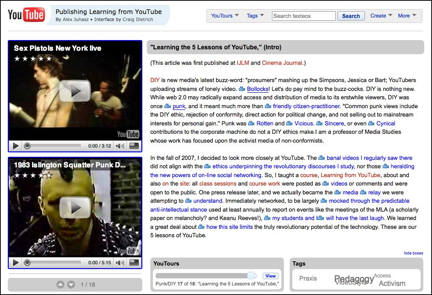
Texteos are the building blocks of the site, and these little architectural wonders allow on-line media scholars like myself the obvious, but until now difficult opportunity to link text and video into discrete, interactive, multi-modal blocks of media writing.
My texteos are tagged with twenty-two terms, of my selection, that themselves powerfully inform the user about my analysis of the site. To follow them is to engage with a more random, yet still highly structured view, of my analysis. The YouTours, on the other hand, are fifteen works of carefully crafted montage, where an argument’s beginning, middle, and end is constructed through time by videos+text—texteos—sometimes carefully hitting up against each other as well as smoothly rolling an idea forward. Our triage pages (as well as search function) provide what YouTube will not: a clear itemization of all the site holds and the shapes of its several simple structures.
1) Audience
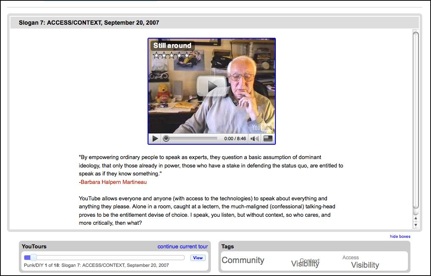
When you go online, your readers (and writers) (can if you wish) include non-academics (like geriatric1927). This raises a thorny question: to what extent do you actually want them to talk and listen? In this “slogan”—a texteo that allows text and video to hold equal weight and space of a page’s argument—this question, among others, is raised and answered in a complex, multi-modal form of montage-writing. In video, we see a YouTube celebrity, geriatric1927, known for his homegrown YouTube knowledge, who is cut against or beside the theoretical writing of the 1970s feminist, activist, documentarian, Barbara Halpern Martineau (who you can follow off-site if you wish through the red-link), who is included herself as another sort of expert speaking against and for a new kind of (common) expertise. Then, my knowledgeable, authorial voice rounds out the trio. Here, three diverse authorities, in harmony and opposition, dialogue about the heady stakes of expert-media-knowledge production. The three voices also serve to begin the “Punk/DIY” YouTour, they comprise the first of fifteen texteos carefully chosen and structured to create a linear path amongst the many competing barbs and beliefs about this quite thorny opposition that occur within the diverse content of the larger video-book.
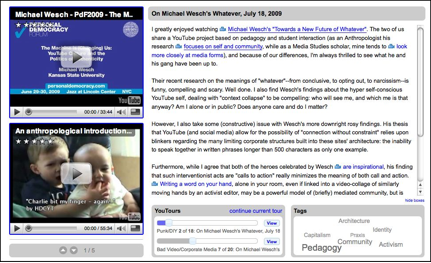
When you write online, the users’ experience is defined by distraction (try playing Michael Wesch’s ‘Towards a New Future of Whatever’” while also reading…), which works against the more typical commitment engendered by the logic, ritual, expense, and conventions locked into a book (try also playing the second video, “An Anthropological Introduction to YouTube” now, while allowing “Towards a” to continue, and also re-commence reading).
In this texteo, you should also take note that through its design and structure, text is supposed to be dominant while video is included to serve more as an illustration, signaled by its placement on the side. Obviously, my gentle suggestion above, to play two videos while reading my writing, undermines my own best intentions. But this is on-line publishing and reading! Authorial intent be damned. Attention will wane against your own best designs. Writer beware! Reader, go for it…
Even so, in this texteo, you might note that I still write short, hoping not to produce the deadly scroll. I also choose to write in my blog voice, to create a chummy casual intelligence (this Lady Professor’s version of the discrete charms of geriatric1927), and I provide lots of videos, too, for the fun factor!
But could there actually be too much fun, too many hugs? It was my technologist boyfriend who first suggested to me that the user would play all the videos at once if granted this cool opportunity. In online publishing, one problem creates another solution. For instance, regarding my perennial duration troubles (reading that includes video watching takes longer: the unwanted time-count of the “video-book”), if you play all the videos on this site or even this page on their own, alone, in real time, the distraction conundrum returns in direct proportion to the length of required play. People skim text and video online. A book is supposed to be long, slow, and linear.
3) Design. This is, of course, another response to the attention/commitment quagmire of digital humanities writing. The better the design the longer the stay (and play). On our site there are three designs for the texteos, two of which you’ve already seen (1) slogan and 2) text-heavy), and all of which are held in a framework beholden to, speaking alongside, and working against that of its subject, YouTube.

This texteo is a video (and actor) alone, making his plea solo on the page, riding the wave of celebrity.

The celebrity train carries us onward along the Punk/DIY train with “On Upper-Crass Video and the Washington Post: April 17, 2008,” a long piece of writing that contrasts my own small-scale activist video with the huge viral power of convergence.

As you can see, “vernacular video in culture and education,” “H. Rheingold” actually takes you off the site, or as they sometimes say, off-book, and I’ll get back to that problem when I soon discuss interactivity and also borders.

Finally, as far as design, BOWS & FLOWS: Composing your Own is, to my mind, a beautifully rendered slogan. If you play both videos here at the same time, you’ll see that the vibrant dynamism of the fire truck wonderfully illustrates Professor Czikszentmihalyi’s more staid presentation, both, of course, about joy. On this texteo, the ideas of author/audience/access/expertise so far raised by the first videos of the Punk/DIY tour continue through the linked/competing voices of psychologist, firefighters, and me.
4) Interactivity is highly controlled on this site. This is a continuation, in its architecture and ethics, of a question already posed in the DIY/Punk tour: namely, should your readers, who may or may not be experts, be authors, too? Here, we can return to Rheingold’s “Vernacular Video in Culture and Education” sitting on Blip.tv, where he waxes rosily on, with an oddly corporate-video feel, about the power of user-made video. Of course, “Deliverance” is from Hollywood, although also too about the regular (if perverted) peeps.
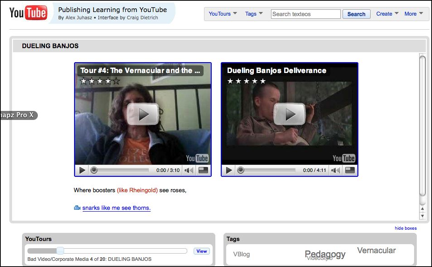
Is authoring (or interactivity) with minimal, stripped, corporate, or converged context a worthy goal in its own right? This is the subject of the next texteo on the DIY/Punk tour, “ The Safety Dance: May 5, 2009.”
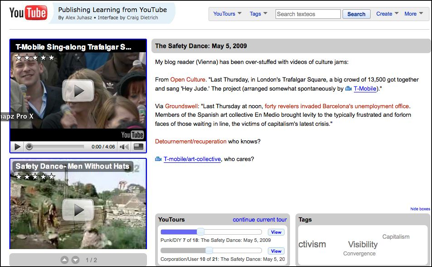
Furthermore, as you can see, there is no place for the sand-lot culture of comments on my “book,” this rowdy, chaotic, uncontrolled verbiage would only slow and mess the reasoned flow!
5) Linearity
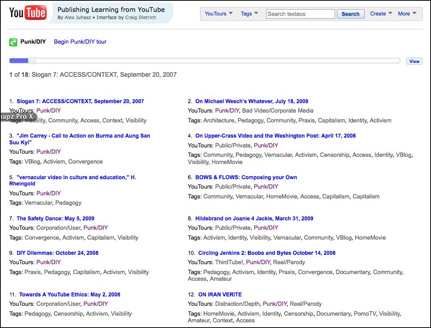
See the straight blue line on the top? It shows how badly I want the peaks and flows, beginnings and ends, surprises and connections of a carefully constructed critical argument (and associated reading practices) in my “video-book.”
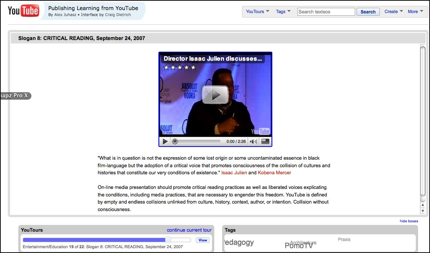
Online, linearity, and most other forms of reasoned connection go out the window in favor of networks, unless you force it. I argue against empty collisions here.
6) Multi-modal.
If you try your hand by using the Pedagogy Tag now, I can demonstrate that even by moving with this less rigid navigational device, the argument I want will continue (any of the texteos you might chance on say what I believe about Pedagogy). And it will, by design, be made through carefully chosen videos (usually not my own: which leads to some complicated questions of rights and ownership for my publisher) as well as through my words.
7) Borders: By using our triage function

The user sees all the limits as well as the guts of my site: everything it holds and how it is ordered. Here, you can also make sense of its networks (its tours and tags). But, because it’s online, these carefully scripted page(s) need never close. I can and will keep adding things, but then I have to keep building tours. Somehow, there’s never a conclusion, even if I insist on enforcing straight lines.
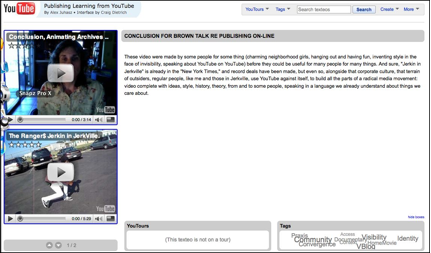
(Another) Conclusion also available as a vlog on YouTube
Early on in my YouTube project, I disavowed the nomenclature "digital humanist" because I realized that this "new" field was merely asking more traditional humanities scholars to take account of things that those of us on its margins have been practicing for many years. Here, I am referring to the many academic artists and activists who have long been pushing the humanities to transform to include the practices, processes, and forms we always need to do our work: collectivity, affect, aesthetics, audience, time and space (place), and ethics.
As my YouTube project matures, however, I realize that what I had previously done in the name of integrated hybrid humanities processes and theories towards AIDS or anti-war activism, for instance, was nevertheless a continuing, if conscious, silo-ing of my efforts: academic writing for academics; video writing and collective processes for activists; feminist methods—the personal is the political, a handmade aesthetic—for artmaking; with lots of slipping and morphing here and there, to be sure. While my content stayed relatively consistent, I self-consciously altered forms to match my various goals inside and outside academia.
Attempting to “publish” this book (and article) online has radically pushed my sense of my own practice because its never-paper habitat raises the possibility, or even likelihood, of a re-integration of these relatively distinct communities and forms. More so, in the face of this re-assimilation, I hate to admit the obvious, but my responses have proven to be downright conservative, which is to say that I wanted to produce forms that seek for structure, order, and the retaining of regimes of difference, discipline, and expertise because this keeps things small, focused, and organized (which is to say, I stayed committed to the local and goal orientation of activism), and because this allows me to express ideas through affect, personal experience, and within a community (which is to retain the vocabularies of feminist art to which I am committed).
I believe in work that comes from an explicit place, that responds to stated goals, and is empowered by media histories and theories, resulting in specific forms constructed for an intended audience. I do not think these are generic objects that can “go viral.” I do not think these are boundariless bits that keep growing and linking. I am afraid of your ire at my conservative, old-fashioned values. I am sure you can give me examples of large, multi-vernacular, flattenings that work. And I thank you for these examples. However, I want for what I have learned from over twenty years pushing at the humanities and three more years working on and against YouTube, to compliment this new conversation.
(The Ranger$ Jerkin in JerkVille, ThemPRangers)
When I watch this jerkin video, it is not the fact that it has gained over one million views that moves me. Rather, it is that this video came from some place, South Central Los Angeles by the looks of it, before it went to any place, or every place, or no place. In this place, they laughed off its bad quality; that was outside their point, beyond their scope. The video was made by these people for some thing (charming neighborhood girls, hanging out and having fun, inventing style in the face of invisibility) before it was useful for many people for many things. And sure, it’s already in The New York Times, and record deals have been made, but even so, alongside this corporate culture, this terrain of outsiders, regular and critical people, like me and my students, use YouTube against itself, to build all the parts needed for a radical media movement: video complete with ideas, style, history, theory, from and to some people, speaking in a language we already understand about things we know and care about.
Enculturation Conclusion: On Database Writing 1
My purpose and problem here, where I reflect upon turning my multi-modal writing into various digital academic publications, is that I am actually authoring in and through a database. In The YouTube Reader, eds. Pelle Snickars and Patrick Vonderau, there are several attempts (see Snickars, Prelinger, and Schroter) to theorize YouTube as an “archive,” and its many related obstacles: of preservation, comprehensiveness, mobility, sharing, ownership, and coherent categorization. My current contract negotiations with MIT Press around publishing this project reflect these and related archive/writing concerns. Most paradigmatically, even as the Press wants to ”go digital,” it is not yet capable of thinking of a “book” as a “database” (although we’re working together on this, and I am certain we will figure it out soon!) asking me to deliver only the written words of “The Work” (but not its videos, code, or design) in a Word document (even though it is authored in a database through html and php). Related questions of whether there should be versions (and how these would be vetted as well as proofread), how it should be “proofread,” and credit and ownership, are also raised. Feel free to read my blog about this “Contractual Mayhem” or wait for it, too, coming soon in the video-book, because of course, what has proven definitive about YouTube, and this work about it, is its highly self-reflexive nature: a database about databases, an archive about archives, publishing about publishing.
Enculturation Conclusion: On Database Writing 2, by Craig Deitrich
To publish "Learning from YouTube Online," I have worked closely with artist, designer, and programmer, Craig Deitrich. In his contribution for an upcoming anthology Handbook of Research on Technologies and Cultural Heritage: Applications and Environments (eds. Georgios Styliaras, Dimitrios Koukopoulos and Fotis Lazarinis), he writes about his thinking and efforts as we work together to write and publish with databases:
“Billed as the future of the Internet, a true Semantic Web is still a largely theoretical concept. Many systems are using the two major technologies that enable it—XML and RDF—more as a flexible data syndication medium than a full semantic framework. The Vectors Journal, a unit at University of Southern California’s Institute for Multimedia Literacy, is doing a little of both. Working with the Alliance for Networking Visual Culture, they are leveraging the syndication properties of RDF to merge metadata from external video archives while also applying ontological principles into the front-end interface. In their soon-to-be-released academic publishing platform named Scalar, classifications of content (immeasurably expansive in academia) can be added to the RDF model without requiring a programmer to update database tables to represent them. The class data is then available to new interface widgets made by their development community. Influencing Scalar’s development is a project developed by filmmaker Alex Juhasz with the Vectors team in 2009, named ‘Learning From YouTube.’ … The team realized that, depending on the length of the text, number of videos, or topic, the arrangement (“view”) of the content should change between pages. The text-centered and media-centered views of Juhasz’s project are similar in design but provide enough distinction to meet the needs of the content. This led to a concept key to the future of Scalar: rather than conforming content to a single universal template, Scalar will feature an option for users to change views of content on the fly within the page. Users will see text, image, and video displayed in different orientations chosen from a pulldown box, including grid and graph views. The symbiotic functionality of different views provokes viewers to re-consider the interfaces to knowledge that users have come to expect. When users ponder interface as the surface node of a large network underneath, they begin to understand the influence that computing paradigms have on their interpretation of information.”